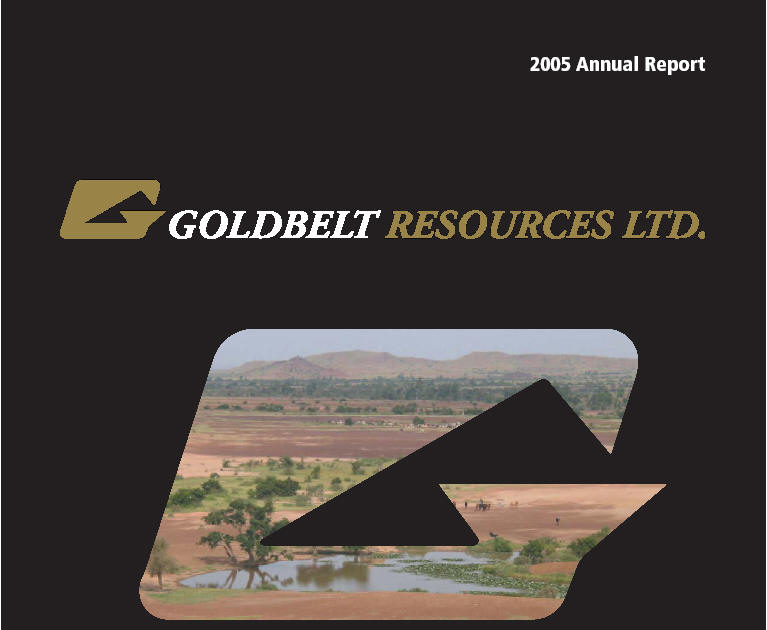
Establishing a significant and profitable mining,company in West Africa
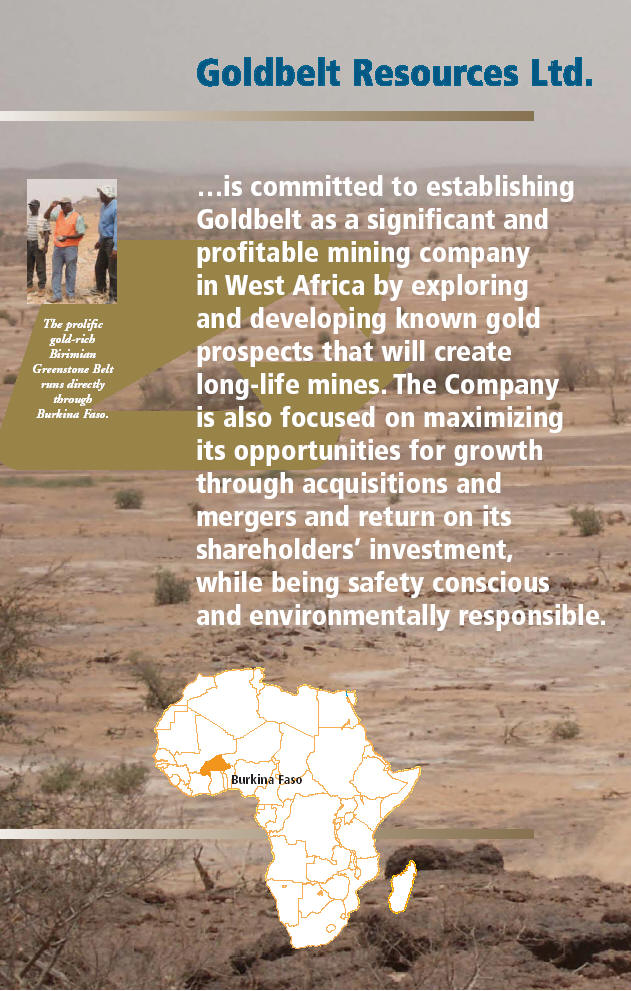
| Contents |
| | Profile | | |
| 1 | Highlights | 13 | - Minfo |
| 2 | Chairman's Report | | - Inata East |
| 3 | Chief Executive Officer's Report | | - Inata West |
| 3 | Burkina Faso | | - Souma Village |
| 4 | Major License Areas | 14 | BSF16 Prospect |
| 7 | Project Development Inata Project | | BSF1 Prospect |
| 12 | Exploration Projects | | Fete Kole Prospect |
| | - Inata North, | 15 | Other Exploration |
| | Central,South | | Licenses |
| | | | - Houndé Area |
| | | | - Belahouro Area |
| | | | - Ouedrogo |
| | | 16 | Corporate Information |
Goldbelt Resources Ltd.
Projects in Burkina Faso,West Africa
Highlights
Goldbelt Resources Ltd.acquired Resolute Limited assets on March 3,2005. Goldbelt has completed the detailed evaluation of the mineralization of the Inata Project,Belahouro License.
Goldbelt has upgraded and increased its National Instrument 43-101 estimated resource of the Inata Project of the Company's Belahouro Project.
Total measured and indicated resources have increased to 933,000 ounces of gold and inferred resources have increased to 226,000 ounces of gold, more than doubling the resources since acquiring the project.
The current planned work program is to make a production decision in early 2006 by completing feasibility and environmental studies and to make application for an Exploitation License while advancing defined projects in the Belahouro license area.
Goldbelt has acquired an additional 1,000 square kilometres of new highly and prospective exploration tenements at Gusselnay and Oka Gakinda (north of Belahouro);Mandiasso and Diosso within the Houndé greenstone belt and Ouedrogo within the Koupela greenstone belt.
Goldbelt is actively pursuing other mining opportunities in West Africa.
Goldbelt is actively pursuing other mining opportunities in West Africa.
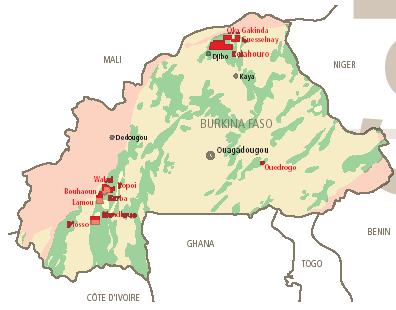
| GOLDBELT RESOURCES LTD. | 2005 ANNUAL REPORT | 1 |
For Goldbelt Resources Ltd., 2005 has been a year of exciting progress, providing much promise of growth. Goldbelt raised $8.0 million and completed the acquisition of Resolute West Africa. The assets, all of which are in Burkina Faso, included the Belahouro Exploration Permit (1,187 square kilometres), two additional exploration permits, vehicles, field camps, offices and equipment, along with a staff of highly skilled people, including 9 geologists. The office based in Ougadougou, the capital of Burkina Faso is ably led by Francois Ouedraogo (Chief Geologist) and Yves Hiberc (Office Manager).
In early March 2005, Laurence Marsland became a welcomed addition to the Board. Laurie brings a wealth of mine development and corporate expertise to the Board of Goldbelt.
Goldbelt has increased the level of expertise of the management team in the head office in Toronto. Collin Ellison (Chief Executive Officer) brings a high level of mining expertise, having developed, built and operated 12 mines throughout the world, rarely seen in junior companies. Hemdat Sawh (Chief Financial Officer), who is a well known and respected professional in the financial community has also joined the Company.
Since the acquisition, Goldbelt has completed an aggressive drilling program in the Inata Project area, more than doubling the resources. Current resources are estimated by independent consultants to be 933,000 oz gold (Measured and Indicated) and 226,000 ozs gold (Inferred). There is an additional 503,500 oz gold (Inferred) located on other prospects within the Belahouro Exploration Permit.
We are completing a scoping study prior to embarking on a feasibility study to determine the means to minimize the initial capital and operating costs to move the project to production as quickly as possible. Applications for a Permit to mine are in preparation and expected to be lodged with the government this year.
We have also applied for and been awarded new exploration permits covering some of the most prospective grounds in Burkina Faso.
Goldbelt is looking forward to a very exciting 2006.
I would like to thank our staff and the Board of Directors for their continuing support and able assistance during 2005.
On Behalf of the Board of Directors

Paul J.Morgan
Executive Chairman
October 28, 2005
"For Goldbelt Resources Ltd., 2005 has been a year of exciting progress, providing much promise of growth."
Establishing a significant and profitable mining company in West Africa
2
Chief Executive Officer's Report
The Country
Burkina Faso has a land area of 1,200,000 square miles, with a population of 12 million people and is located between Ghana, Cote D'Ivoire, Mali, Niger, Benin and Togo. Its major industry is agriculture and its principal export commodity is cotton. The emergence of mining in Burkina Faso is seen by the Burkinabe government as its best opportunity to develop a new industry and garner much needed foreign currency, consequently there is significant support in Burkina Faso for foreign investment in mining.
Burkina Faso is a politically stable country with a democratically elected government and newly developed mining and environmental legislation in place.
Burkina Faso means the land of honest men and is recognized as one of the most stable and secure African countries.
The Geology
Burkina Faso, West Africa is situated on the Birimian greenstone belt which is contained within the West African Shield. The Birimian Series of West Africa host some of the largest gold deposits in the world, including Sadiola, Yatela, Morila and Syama in Mali, Siguiri in Guinea, and Obuasi, Bogosu, Prestea, Bibiani and the recent Newmont 18.0 million ounce discovery (Akyem and Ahafo) in Ghana, and is comparable to other Archean and Proterozoic shields in Canada, Australia and Southern Africa.
Your Company
Goldbelt tenement holdings in Burkina now total 3,400 square kilometres contained within eleven exploration licenses these being Belahouro, Gusselnay, Oka Gakinde within the Belahouro region; Karba, Kopoi, Wakui, Bouhaoun, Lamou, Mandiasso and Diosso within the Houndé region and Ouedrogo within the Koupela region. The Belahouro tenement (1,187 square kilometres) is the most developed exploration license and contains a number of advanced projects. See maps and website for detailed aspects.
3

| The Belahouro
permit is located
in the western
part of the
Djibo greenstone belt... | 
|
Belahouro Project License
The Belahouro license is located 220 kilometres north of the capital Ouagadougou and approximately 45 kilometres south of the Mali border. The license covers an area of 1,187 square kilometres and contains 10 known exploration projects. A resource estimate has been established on 5 of these exploration projects: Inata, Minfo, Fete Kole, BSF1 and BSF16.
The historical and recent exploration activity has had a major focus on the Inata project.
Belahouro Geology
The Belahouro permit is located in the western part of the Djibo greenstone belt, part of the Birimian greenstone belt. The age of these formations is estimated to be from 1.6 to 2.3 billion years old. The weathering profile in the region is extensive and persists down to 100 metres depth and has a well developed laterite profile.
The geological interpretation of the Belahouro Project area initially relied on the interpretation of geophysical data and geological mapping of very limited weathered outcrop. This has been significantly enhanced by the results obtained from a number of exploration drilling programs employing different drilling techniques such as rotary air-blast (RAB), reverse circulation (RC) and diamond core drill holes.
Deposit Types
Gold within the Belahouro Project is exclusively associated with deep crustal deformation, regional metamorphism and mesothermal vein style mineralization. This is entirely consistent with the majority of Archaean and Proterozoic terrains worldwide, including the Birimian Series of West Africa.
The main deposits are:
Inata trend gold deposits (Inata, North, Central and South, Sayouba and Minfo) in Damba-Inata volcano-sedimentary Province.
Souma-N'Darga trend deposits (Souma Village, BSF1, BSF16 and N'Darga) in the eastern margin of Sona-Belahouro Basin.
Fete Kole deposit in Fete Kole volcanic Province.
The 1,187 square kilometre project landholding can be separated into three principal geological domains as indicated on the Belahouro Project map.
"The license covers an area of 1,187 square kilometres and contains 10 known exploration projects."
Establishing a significant and profitable mining company in West Africa
4
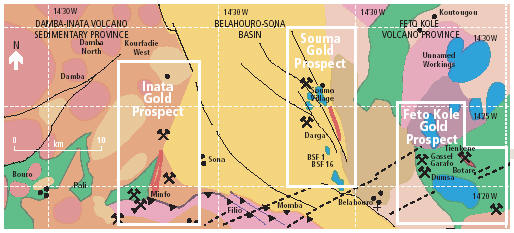
Damba-Inata Volcano Sedimentary Province
The Damba-Inata domain occurs in the westernmost portion of the project area and is dominated by metasediments, intermediate to mafic volcanics and volcanoclastics. To the west of the Inata trend, strong magnetic signatures are present in aeromagnetic data which correspond to mafic volcanics and their sedimentary derivatives, such as pillow breccias. The trend varies over the strike of the prospect, from north-northwest in the south to north in the central area and north-northeast in the northern area.
Inata Trend Deposits
The principal gold mineralization is confined to the Inata and Souma trends. The three Inata deposits (North, Central and South) are located over a strike length of 4 kilometres. The deposits are interpreted to be related to the same structural regional shear along the western margin of the Sona-Belahouro Basin. The Inata Central and Inata South represent the same mineralized trend, separated by lower grade mineralization and cross-cutting faults. Inata North lies some 300 metres west of the Inata Central-South trend. The Inata shear trends north-northeast and dips steeply to the west-northwest.
Gold mineralization is present as free grains and is generally associated with carbonate-pyrite alteration within quartz veins.
Sayouba is a small zone (strike 100 metres) of north-northwest trending gold mineralization with a dip of 60° to 70° west. It occurs in shale, siltstone, minor intermediate volcanics, and felsic porphyry.
Minfo lies on the Minfo-Filio east-west shear zone. The shear zone can be traced over a distance of 20 kilometres and is characterized by a wide zone of shearing (up to 400 metres) associated with a strong aeromagnetic trend. Mineralization is associated with massive and stringer quartz veining in black shales within an intermediate volcanic shale/siltstone package.
Souma-N'Darga Trend Deposits
Belahouro-Sona Basin lies in the centre of the Belahouro property. It is a rift basin with deep crustal fault margins gently plunging north with rocks consisting of turburbitic meta-sediments and minor volcanoclastics. The basin forming structures have later been reactivated in subsequent phases of compression deformation. Late stage north-east to south-west faults crosscut the basin and provide channel ways for mineralizing events along the rift margins.
| GOLDBELT RESOURCES LTD. | 2005 ANNUAL REPORT | 5 |

| The Inata Project database
consists of 3,312 metres of
diamond core drilling and
78,618 metres of reverse
circulation drilling. | 
|
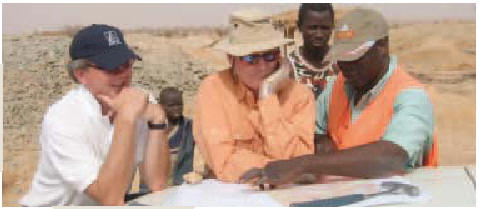
The Souma-N'Darga trend is located along the eastern structural margin of the Belahouro-Sona Basin, immediately west of the contact with the deformed Belahouro granite.
Mineralization comprises laminated quartz ± tourmaline veins that outcrop sporadically along the entire trend, and has been separated into several separate prospects: BEF2, BSF1, BSF16 and Souma Village. The western trend comprises N'Darga and Boulili deposits.
Fete Kole Province Deposits
The Fete Kole province occurs to the east of the Belahouro-Sona Basin and is a near vent complex of felsic to mafic volcanics and basin type sediments cross cut by various pre-, syn- and post deformation granitoid intrusions recently dated at 2.1 to 4.0 billion years old. The final phase of intrusion in the Fete Kole province is gabbroic, which is also associated with minor volcanic ultramafic sequences.
The Fete Kole volcano-plutonic province is marked by the dominant northwest-southeast trend of foliation and quartz tourmaline veins. Dip is generally to the west. Two structural sectors are distinguished from aeromagnetic analytical signal image. They are divided by a well defined major structure which separates predominantly intermediate volcanic rock in the south from predominantly mafic and ultramafic rocks in the north.
A table of the Belahouro projects resources is summarized below:
Belahouro Projects Resource Table (at a cutoff grade of 1.0g/t)
| | Measured & Indicated | Inferred |
| | Tonnage | | | Tonnage | | |
| Deposit | (Million t) | Au g/t | ozs | (Million t) | Au g/t | ozs |
| Inata | 10.297 | 2.5 | 818,000 | 2.811 | 2.0 | 177,000 |
| Minfo | | | | 0.604 | 2.4 | 46,000 |
| BSF1 | | | | 0.463 | 3.0 | 44,600 |
| BSF16 | | | | 0.170 | 2.0 | 10,900 |
| Fete Kole | | | | 4.636 | 2.7 | 402,000 |
| Total | 10.297 | 2.5 | 818,000 | 8.684 | 2.4 | 680,500 |
Establishing a significant and profitable mining company in West Africa
6
Project Development
Inata Project
Goldbelt and the previous owners of the Project (BHP and Resolute Resources) have, to date, expensed approximately $27 million on geological and technical studies within the Belahouro license area with the majority of these funds being focused on the Inata project.
This has provided Goldbelt with an exceptional opportunity through the establishment of an extensive historical database involving geophysical and geochemical exploration results, geotechnical and metallurgical testwork studies and environmental study reports to a pre-feasibility level.
The Inata Project database consists of 3,312 metres of diamond core drilling and 78,618 metres of reverse circulation drilling.
Additionally, drilling has also been completed at other project areas within the Belahouro license where zones of mineralization have been determined. These are Minfo, Folio, Souma Village, BSF1, BSF16, Fete Kole and Pali.
In March 2005, immediately after completing the acquisition, Goldbelt successfully designed and instigated a new drilling program at Inata to increase the level of resource confidence, to test continuity of the mineralization along strike and down dip extensions. All holes drilled in the resource definition program were restricted to the Inata North, Central and South mineralized areas.
The drill program also provided additional mineral samples for a new metallurgical testwork program of the oxide mineralization and for the analysis of rock strengths (geotechnical) for the preparation of a feasibility study.
In total, 183 reverse circulation (RC) and 13 diamond core drill holes were completed with a total of 21,750 metres being drilled.
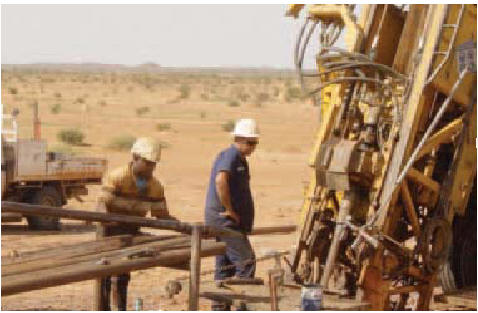
| GOLDBELT RESOURCES LTD. | 2005 ANNUAL REPORT | 7 |
 | 
|
The resource definition drilling program was successfully completed in late June 2005... | Inata Central Deposit Area
Cross section looking west |
The drilling program involved 179 reverse circulation holes designed to better define the mineralized boundaries, 3 diamond core holes and 4 reverse circulation holes from surface for the collection of metallurgical samples, 8 diamond core holes from surface for collection of geotechnical and structural samples for rock strength and structural integrity evaluation, and 2 deep diamond drill holes to test the depth extensions of high grade ore zones at Inata, which will enhance the geotechnical drilling.
The resource definition drilling program was successfully completed in late June 2005 and the additional technical drilling in September 2005.The drilling results demonstrated excellent continuity in the mineralization zones and exposed new extensions which are to be tested within the next drilling program.
The drilling program provided the necessary additional information on the extension and continuity of the Inata mineralization for the purpose of upgrading the Inata resource model. Additional sample material was also obtained for utilization in a metallurgical testwork program of the oxide mineralization and for geotechnical analysis of the adjacent lithologies in preparation for the development of a feasibility study.
A large number of significant mineralized zones were intercepted within the drill program, some of which are listed below:
| Inata North: | INRC777 51m @ 3.94g/t | Inata Central: |
| | (includes 18m @ 9.39g/t) | |
| INRC740 31m @ 3.26g/t | INRC778 29m @ 2.33g/t | INRC765 21m @ 2.79g/t |
| INRC741 35m @ 3.17g/t | INRC779 34m @ 3.55g/t | INRC766 11m @ 4.07g/t |
| INRC742 36m @ 5.12g/t | (includes 14m @ 5.05g/t) | INRC841 10m @ 10.79g/t |
| INRC743 39m @ 3.99g/t | INRC781 28m @ 4.29g/t | INRC850 14m @ 4.09g/t |
| INRC744 29m @ 6.61g/t | INRC800 21m @ 5.55g/t | |
| INRC746 28m @ 6.75g/t | INRC818 33m @ 4.94g/t | |
| INRC749 30m @ 2.48g/t | INRC830 17m @ 4.02g/t | Inata South: |
| INRC752 44m @ 1.68g/t | 15m @ 4.65g/t | |
| INRC754 28m @ 6.67 g/t | INRC832 61m @ 3.12g/t | INRC794 23m @ 2.37g/t |
| INRC755 26m @ 9.69 g/t | INRC833 36m @ 3.69g/t | |
| INRC760 76m @ 1.73 g/t | INRC886 15m @ 4.67g/t | |
| INRC773 33m @ 3.42g/t | INRC887 19m @ 3.19g/t | |
| INRC775 31m @ 8.02g/t | INRC890 15m @ 3.19g/t | |
| (includes 19m @ 12.40g/t) | | |
| INRC776 20m @ 3.52g/t | | |
| (includes 12m @ 5.94g/t) | | |
"These high grade zones carry a significant proportion of the resource ounces and will be the focus of the future resource assessment and development process."
| 8 | Establishing a significant and profitable mining company in West Africa |

Inata North Deposit Area
Cross section looking west
Inata Resources Estimate:
The resource estimate carried out by RSG Global of Perth, Australia has incorporated all of the historical and current drilling prior to October, 2005. RSG Global recommended that a 0.5 grams per tonne cutoff be used for the resource statement, the results of which are summarized below.
INATA Resource Table
Subdivided by CNI 43-101 Resource categories @ 0.5 g/t cutoff
| Measured | Indicated | Measured & Indicated | Inferred |
| Tonnage | | | Tonnage | | | Tonnage | | | Tonnage | | |
| (Million t) | Au g/t | ozs | (Million t) | Au g/t | ozs | (Million t) | Au g/t | ozs | (Million t) | Au g/t | ozs |
| 1.396 | 3.0 | 132,500 | 13.647 | 1.8 | 800,500 | 15.043 | 1.9 | 933,000 | 4.869 | 1.4 | 226,000 |
The low volume of measured resources was due to insufficient bulk density measurements. This issue will be addressed within the feasibility study and prior to our reserve statement.
The current resource, using a cut-off grade of 1.0 grams per tonne, is estimated by RSG Global of Perth, Australia, as follows:
INATA Resource Table
Subdivided by CNI 43-101 Resource categories @ 1.0 g/t cutoff
| Measured | Indicated | Measured & Indicated | Inferred |
| Tonnage | | | Tonnage | | | Tonnage | | | Tonnage | | |
| (Million t) | Au g/t | ozs | (Million t) | Au g/t | ozs | (Million t) | Au g/t | ozs | (Million t) | Au g/t | ozs |
| 1.270 | 3.2 | 129,000 | 9.027 | 2.4 | 689,000 | 10.297 | 2.5 | 818,000 | 2.811 | 2.0 | 177,000 |
It is recognized that there are a number of high grade zones contained within each of the three Inata deposit areas (North, Central and South). These high grade zones carry a significant proportion of the resource ounces and will be the focus of the future resource assessment and development process.
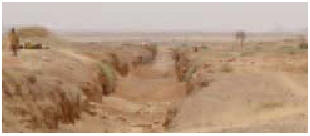
| GOLDBELT RESOURCES LTD. | 2005 ANNUAL REPORT | 9 |

| The Inata mineralization is
favourably situated for the
establishment of an
open pit mining operation. | 
|
The following sections show the mineralized high grade zones for 1) Inata North Central and 2) Inata North deposits.
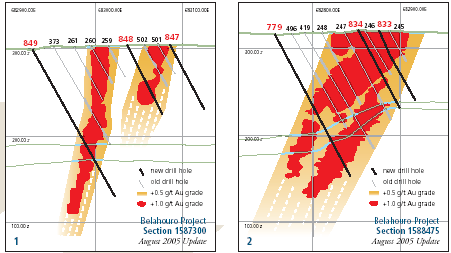
Details of the key assumptions, parameters and methods used to estimate the mineral resources are reported in Goldbelt's press release dated October 19, 2005.
Inata Technical Studies
The Inata project has a wealth of information generated over 9 years, previously by BHP and Resolute, and more recently by Goldbelt. This database includes metallurgical and geotechnical testwork as well as environmental and sociological evaluations. The results of the earlier studies form the foundation of the current study work being undertaken. Hence, the feasibility study provides the additional detailed assessment and optimization of the previously completed technical areas of metallurgical, environmental, sociological and financial evaluation. This significantly reduces the time and cost for completing the feasibility study.
Scoping Study
A Scoping Study will be completed in November, 2005 and will evaluate a number of process flowsheet designs and production rate options. These include conventional carbon-in-leach, heap leach or a combination of the two technologies at annual production rates ranging from 1.0 million tonnes per annum to 2.0 million tonnes per annum. Capital and operating costs were estimated for each option.
The Inata mineralization is favourably situated for the establishment of an open pit mining operation.
It is anticipated that a number of shallow open pits will be developed within a short haulage distance from a centrally located process plant.
It is also recognized that there are a number of high grade mineralized zones within each of the deposits which, due to their grade and extent, have the potential to be later exploited from an underground operation.
The study additionally will evaluate the infrastructural requirements and assess the environmental impact of each processing option. The results of the scoping study will form the basis for the Inata Project feasibility study scope of work.
| 10 | Establishing a significant and profitable mining company in West Africa |
Feasibility
The most significant technical issue to be addressed in a feasibility study is that of resource evaluation. Within the resource evaluation are included sections on geological and structural setting, extent and grade of mineralization, rock strength and densities as well as mineralogical, metallurgical and hydrogeological characteristics. All of these issues have been addressed to a pre-feasibility study level, whereas the resource estimate has been evaluated to a feasibility study level of accuracy.
The technical areas that are still to be addressed to a feasibility level of accuracy are mine design, metallurgical and geotechnical (rock strength characteristics). The sample material for the necessary testwork was successfully obtained from the recent drilling and will be the subject of an upcoming testwork program, available by early December, 2005. These results will detail the feasibility level (generally accepted as ± 15% accuracy on capital and operating costs) mine design, process flowsheet and engineering design and project infrastructure. These areas will have previously been developed to a ± 35% accuracy on capital and operating costs within the Scoping Study. The development of the water supply for the feasibility is also required to be finalized.
The sociological aspects of the feasibility study contain the environmental impact assessment, sociological evaluation and environmental management plan. These issues have also been studied to a pre-feasibility level. A new environmental baseline, sociological and environmental impact study commenced in early September and is to be completed by mid November, 2005. The initial study was carried out by SRK consultants from South Africa. A more detailed study is presently being conducted by Socrege SARL, a Burkina Faso environmental group. Socrege is the only registered environmental group operating in Burkina Faso and has provided similar consultation for Orezone, Semafo and High River Gold.
Inata Exploitation License Project Study
(Re. application requirements for Burkina Faso)
The Belahouro exploration license is to be converted to a 20 year Exploitation license (mining permit) for the Inata deposit before April, 2006. An application for the Exploitation license, supported by a study report (referred to as a 'Feasibility Report' in Burkina Faso), will be completed and submitted before the end of 2005.
This is four months in advance of the expiry of the Belahouro exploration license. The approval process may take a maximum of three months to complete.
After award of the Exploitation license a new project company will be established within Burkina Faso to hold the Inata mining rights and for the management of the future mining operation. Goldbelt will own ninety per cent of this new company and the government of Burkina Faso will hold ten per cent.
| GOLDBELT RESOURCES LTD. | 2005 ANNUAL REPORT | 11 |
Exploration Projects
Development of Future Resources | 
| 
|
| | ...2.3 million tonnes of mineralization potentially exists... | |
A review of the resource potential was carried out by RSG Global in August 2005 at the request of Goldbelt.The following summary outlines RSG Global's assessment:
Inata North - Northern Extension
After a review of the data, RSG Global provided comment on the potential to define additional resources to the north, along strike (approximately 650 metres), of Inata North. Based on the available information significant potential exists to define additional mineralization in this region, however, it is considered probable the tenor of the mineralization is lower and the mineralization widths will be reduced in comparison to Inata North.
Considering an optimistic strike extent of 650 metres scenario and applying an average zone width of 15 metres, and a down dip extent of 120 metres, 2.3 million tonnes of mineralization potentially exists equating to a maximum of approximately 150,000 ounces.
Inata North - Sayouba
The footwall zones at Inata North are considered to have oxide resource potential and are therefore considered a high priority target. Optimistically, potential exists to define a zone of strike extending 350 metres. This would equate to a potential of approximately 2.0 million tonnes of material for 130,000 ounces.
Inata North and Inata Central Deposits - Infill drilling
RSG Global considers the most likely outcome of infill drilling between the Inata North and Central is to close off the mineralized zones. Little potential exists in this region to convert large oxide ounces into mining reserve. Notwithstanding the previous comments, limited potential does exist to define small additional resources of about 10,000 ounces.
Inata South Deposit
Strong potential exists to extend the Inata South zone south. Drilling in this region indicates some narrowing of the mineralized zones. However, due to the boudinage nature of the mineralization, some pinching of the mineralized zone may have occurred and potential exists for the zone to flex and widen.
A 1,350 metre's strike length remains to be adequately drill tested, this equates to approximately 5.0 million tonnes of potential mineralized material (310,000 ounces).
"Based on the available information significant potential exists to define additional mineralization in this region..."
| 12 | Establishing a significant and profitable mining company in West Africa |
Inata North Potential Underground Resource RSG Global considers that potential exists for developing the high grade central Inata North mineralization down dip, and this zone should be tested by strategically placed diamond drill holes in the future. It is noted however, that mineralization widths and grade tenor at depth appear to be reduced, although some pinching of the mineralized zone may have occurred. A detailed review of structural and mineralization data in this area is recommended prior to proceeding with expensive deep diamond drilling. Minfo Prospect Previous authors have estimated a resource at Minfo of 600,000 tonnes at 2.5 grams per tonne Au for 40,000 ounces. The previous reports were not prepared in accordance with standards set out in NI43-101 and therefore is provided for reference purposes only. The current drilling has adequately defined the known mineralization, including the identified cross cutting structure. Relatively few infill drill holes should enable an upgrade in resource confidence with limited potential existing to define significant addition contained ounces. Inata East-Pali Prospect It is considered that the poor understanding of the geological controls and the narrow nature of the intersected mineralization at Pali does not make a high priority target. Infill drilling of anomalous RAB and RC intercepts by diamond drilling is recommended for this area. A significant intersection BRB846 - 11 metres at 6.6 grams per tonne Au should be investigated at depth. The potential for a significant oxide resource, however, is considered limited based on the current geological interpretation. Inata West - Filio Prospect Similar to the Pali prospect, the Filio prospect is considered a lower priority target which requires systematic further exploration, due to the poor understanding of the geological controls on mineralization and the relatively narrow anomalous intercepts. Infill drilling on anomalous RAB and RC intercepts by oriented diamond drilling is recommended for this area. A significant intersection BRB134 - 24 metres at 2.6 grams per tonne Au was obtained through earlier drilling and is to be investigated at depth. Souma Village Prospect It is considered that the Souma trend, consisting of the advanced exploration prospects of the Souma Village, BSF1 and BSF16, has the potential to yield a large oxide resource. The Souma trend is considered a mineralized structural corridor of at least 11 kilometres from BSF1 to the Tabassi surface sampling. The structural behavior and mineralization characteristics appear similar to Inata. As such, the Souma trend is considered a high priority target. Developing defined mineralization at the Souma Village is considered a high priority. The similar structure behaviour, mineralization widths and continuity to that identified at Inata North, make the Souma Village prospect a high priority target. The potential also exists for multiple en echelon mineralized structures. The Souma trend is untested at depth north of the Souma Village towards the Tabassi surface sampling. This area shows great potential if the structural trend is continuous. | 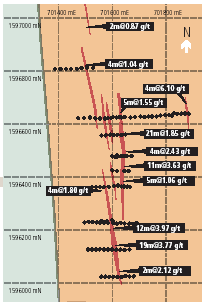 Souma Plan |
| GOLDBELT RESOURCES LTD. | 2005 ANNUAL REPORT | 13 |


...approximately 5.0 million tonnes and potentially 300,000 ounces. | Assuming successful exploration and drilling programs, the optimistic outcome of Souma Village mineralization which continues north with a strike length of 1,500 metres is approximately 5.0 million tonnes and potentially 300,000 ounces. RSG Global considers that further exploration is likely to identify significant additional mineralization. Furthermore, it is reasonable that Souma could yield a similar quantum resource to that identified for Inata. BSF16 Prospect Previous authors (Resolute) have estimated the BSF16 resource as 170,000 tonnes at 2.0 grams per tonne Au for 11,000 ounces. The previous reports were not prepared in accordance with standards set out in NI43-101 and therefore are provided for reference purposes only. Potential depth extensions (below approximately 30 metres) remain untested and drill lines are limited to two holes per section. BSF1 Prospect Resolute estimated the resource for the BSF1 prospect to be 463,000 tonnes at 3.0 grams per tonne Au for 45,000 ounces. The previous reports were not prepared in accordance with standards set out in NI43-101 and therefore is provided for reference purposes only. Depth extensions of the mineralization are not well drilled. Section lines are limited to three holes intersecting mineralization to approximately 90 metres in down dip depth. Similar resource potential exists for the BSF1 prospect to that discussed for BSF16. Fete Kole Prospect Metamorphic Regime Despite the extensive deformation observed in the Birimian volcano-sedimentary series, they seem to have been subject, during the Eburnean Orogeny, to low-grade regional metamorphism to greenschist facies. However, in the Belahouro-Souma area, kyanite bearing mica schist and pelite indicate higher grade metamorphic regime. On a regional scale, the large granite intrusion emplacement developed contact metamorphism such as at Aribinda area. The deposits occur in shear zones. The Gassel Garafo mineralized zone lies proximal to a major north to southeast trending shear zone, which has a known extent of 14 kilometres between Senakaye and Lybie. In the Gassel Garafo area, the shear traverses the contact between granitoids to the west and basaltic andesites to the east. The shear zone that controls the gold mineralization at Gassel Garafo has been tested at Dumsa and Senakaye. The shear zone is dominantly hosted in basaltic andesites and associated pyroclastics. Mineralization was confined to quartz veining within the main shear zone. The Fete Kole mineralization is closely related to a volcanic centre along a regional north south complex shear. Stacked, flat lying structures pond hydrothermal solutions, which have significant high grade zones. Iron carbonate alteration is common throughout the project. |
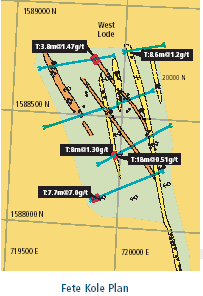 |
| 14 | Establishing a significant and profitable mining company in West Africa |
Fete Kole is the largest area of artisanal mining in the License. Approximately 1,000 miners are active, some digging shafts to at least 60 metres. The artisanal workings occupy an area of approximately 30 square kilometres. The prospect represents a structural more complex area of the Belahouro Project. The structural and mineralization controls are poorly understood. RSG Global considers that a systematic approach to exploration is appropriate at Fete Kole to ensure a maximization of the exploration expenditure. Orientated diamond drilling core, selected for maximizing geological information as opposed to grade, is considered the logical first step in better understanding the Fete Kole prospect.
BHP has estimated the resources as 400,000 oz Au in the area that was previously drilled. The previous reports were not prepared in accordance with standards set out in NI43-101 and therefore are provided for reference purposes only. A series of significant intersections in holes FKRC0012, FKRC0013 and FKC0013 are to be investigated at depth.
Other Exploration Licences
1. Houndé (Karba,Wakui,Kopoi,Bouhaoun and Lamou):
A 16,000 geochemical soil sampling program was carried out early in 2005. The analysis of these samples was completed in late July, 2005. The evaluation of these results and development of a further geochemical soil sampling and/or a RAB drilling program is to be determined.
Other Houndé Area tenements (Mandiasso and Diosso):
These licenses have recently been awarded to Goldbelt and no exploration work has been carried out to date. An initial review of historical data is required for the development of an exploratory soil geochemical program.
2. Belahouro Area tenements (Guesselnay and Oka Gakinda):
These licenses have recently been awarded to Goldbelt and no exploration work has been carried out to date. An initial review of historical data is required for the development of an exploratory soil geochemical program.
3. Ouedrogo tenement,Koupela Region (Central Burkina Faso):
A re-assessment of previous geological data will be conducted before developing a future exploration program. This project is situated in a massive sulphide province and its potential is not as a gold resource but for basemetals.
The technical information contained in this annual report has been prepared under the direction of and has been reviewed by Collin Ellison, Chief Executive Officer of Goldbelt and a Qualified Person under NI 43-101.
Sincerely,

Collin Ellison
Chief Executive Officer
October 28, 2005
| GOLDBELT RESOURCES LTD. | 2005 ANNUAL REPORT | 15 |

Corporate Information
www.goldbeltresources.com
| Directors | Executive Office | Legal Counsel | Trading Symbol |
| | Sterling Tower, | DuMoulin Black LLP | TSXV: GLD |
| Paul J. Morgan | 372 Bay Street, | 595 Howe Street, | |
| Executive Chairman | Suite 1201 | 10th Floor | Investor Relations |
| | Toronto, Ontario | Vancouver, B.C. | |
| Brian Irwin | M5H 2W9 | V6C 2T5 | Contact: |
| Director and Secretary | Tel: 416 364 0557 | | Laura Sandilands |
| | Fax: 416 364 7120 | Transfer Agent | lsandilands@goldbeltresources.com |
| Paul G. Naughton | | | |
| Director | | Computershare | Website |
| | Registered Office | 510 Burrard Street, | www.goldbeltresources.com |
| Laurence D. Marsland | Goldbelt Resources Ltd. | 3rd Floor | |
| Director | 200-204 Lambert St., | Vancouver, B.C. | |
| | Whitehorse, | V6C 3B9 | |
| Management | Yukon Territory, | Tel: (514) 982-7555 | |
| | Canada | (800) 564-6253 | |
| Collin Ellison | Y1A 3T2 | Fax: (416) 263-9524 | |
| Chief Executive Officer | | (866) 249-7775 | |
| | Auditors | E-Mail: service@ | |
| Hemdat Sawh | Davidson & Company | computershare.com | |
| Chief Financial Officer | Suite 1200 | www.computershare.com | |
| | 609 Granville Street | | |
| Morou Francois | P.O. Box 10372 | Share Capital | |
| Ouedraogo | Pacific Centre | (as of October 28, 2005) | |
| Chief Geologist, | Vancouver, B.C. | | |
| West Africa | V7Y 1G6 | Outstanding Shares | |
| | | 34,155,617 | |
| Yves Hirbec | | | |
| Administration | | Warrants and Options | |
| Manager, | | 19,696,172 | |
| West Africa | | | |
| | | Printed in Canada on recycled paper | |
| | using vegetable based inks. | |
| | Production: Walter J. Mishko & Co. Inc. | |
| | Design: Goodhoofd Inc. | |
| | |
| 16 | Establishing a significant and profitable mining company in West Africa |
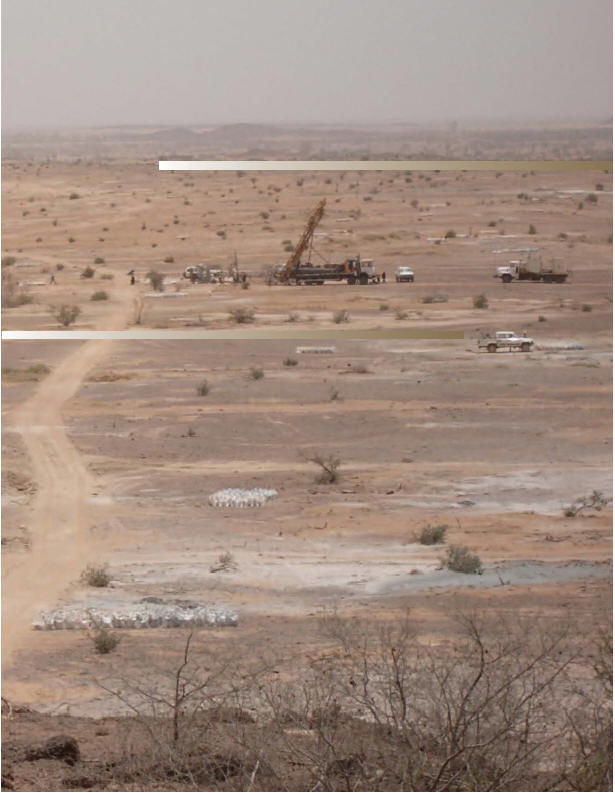

...committed to establishing Goldbelt as a significant and profitable mining company in West Africa by exploring and developing known gold prospects that will create long-life mines.

www.goldbeltresources.com





























